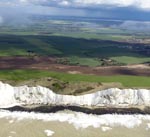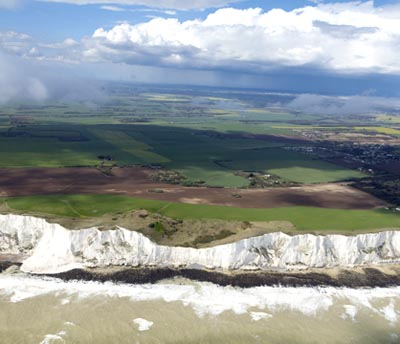National Trust bids for White Cliffs of Dover
The National Trust is launching a bid to acquire a short but well-loved section of the famous white cliffs of Dover


Julius Caesar turned back from them the first time, Louis Blériot landed on them and Vera Lynn sang about them. The White Cliffs of Dover are an unchanging, emotive sight that says ‘home', and the National Trust wants it to stay that way, free from development. This week, the organisation launches a £1 million appeal to acquire a short but well-loved stretch of clifftop. The section, just under a mile long and currently in private ownership, is between the Trust's visitor centre and the South Foreland Lighthouse. The Trust has been given the opportunity to buy the land by the owner and hopes to raise the money by the end of 2012.
Brian Whittaker, the Trust's Kent countryside operations manager, acknowledges that the area is already well managed for agricultural purposes, but says that being able to buy the land would ensure that, in the future, it would be protected from inappropriate development or management. ‘Under an unsympathetic owner, access to the clifftop could be limited to the public footpath,' he notes. ‘Under Trust ownership, we would have an opportunity to manage and improve the quality of public access and maintain the site forever, for everyone. We believe that, by focusing on wildlife, landscape and access, the whole site can be improved to benefit people and biodiversity.'
The Trust plans for areas currently under arable management to revert to open chalk turf, providing a continuous view of about four miles of chalk grassland from the sea. The Trust already owns nearly half of the White Cliffs, which stretch for some 10 miles. Since first beginning to buy up plots of land in 1968, it has adopted various measures to improve rare chalk grassland habitats, which support a unique but threatened diversity of flora and fauna, such as horseshoe vetch and ox-tongue broomrape, and Chalkhill blue and adonis blue butterflies. The cliffs are also an important site for migratory birds, and for cliff-nesting colonies of kittiwake and fulmar.
‘If successful, our main priority would be to continue to graze with sheep, cattle and ponies to control scrub and tor grass,' explains Mr Whittaker. ‘Grazing helps stop the dominance of grasses and other taller species, allowing the specialists to flourish. However, we are also talking to Natural England about re-seeding previously ploughed areas with wildlife and grass seed taken from neighbouring areas already designated as an SSSI.'

In 2005, the White Cliffs were voted the nation's favourite stretch of coastline in a public poll. ‘They have been the first view of the UK for visitors arriving by sea for centuries, so this stretch holds a special place in our national identity,' says Mr Whittaker. The cliffs were indelibly imprinted on the public consciousness in newsreels as the welcoming backdrop for troops returning from the evacuation of Dunkirk in 1940, but their place in history stretches at least as far as the Romans. In 55bc, the sight of the massed forces of Britons along the cliffs was enough to persuade Julius Caesar to turn back from his first planned expedition.
The cliffs also emphasise our connection to the European mainland, sharing the same geology as the French coastline, which can be seen on a clear day. In 1785, the French balloonist Jean-Pierre Blanchard became the first person to make an aerial crossing over the Channel from Dover to Calais. In 1909, Blériot touched down on a low section of the cliffs after making the first heavier-than-air crossing. The South Foreland Lighthouse, which has long helped mariners navigate the infamously treacherous Goodwin Sands, was the first electronically lit lighthouse, and the site of the first international radio transmission.
To donate to the Trust's appeal, visit www.nationaltrust.org.uk/whitecliffsappeal Jack Watkins
Exquisite houses, the beauty of Nature, and how to get the most from your life, straight to your inbox.
Country Life is unlike any other magazine: the only glossy weekly on the newsstand and the only magazine that has been guest-edited by His Majesty The King not once, but twice. It is a celebration of modern rural life and all its diverse joys and pleasures — that was first published in Queen Victoria's Diamond Jubilee year. Our eclectic mixture of witty and informative content — from the most up-to-date property news and commentary and a coveted glimpse inside some of the UK's best houses and gardens, to gardening, the arts and interior design, written by experts in their field — still cannot be found in print or online, anywhere else.
